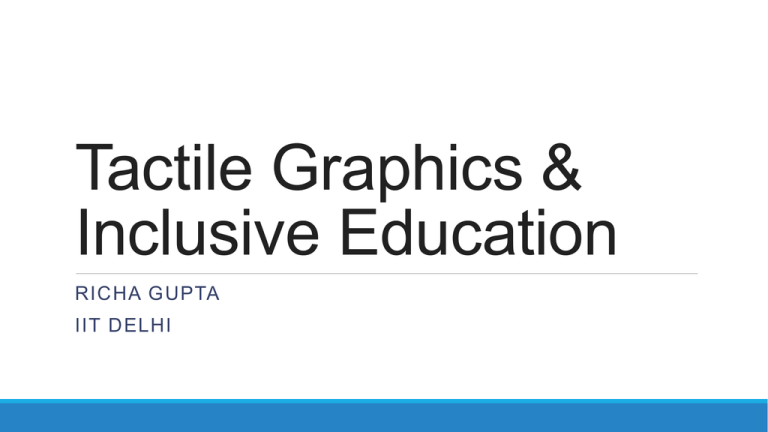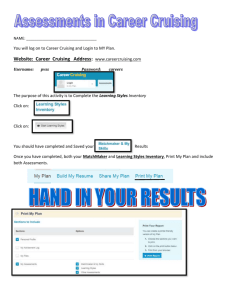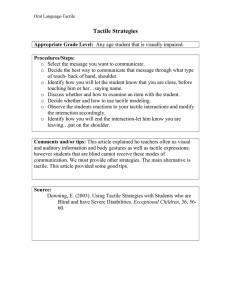advertisement

Tactile Graphics & Inclusive Education RICHA GUPTA IIT DELHI Inclusive education happens when children with and without disabilities participate and learn together in the same Current Situation Most schools do not admit visually impaired children Educational text books do not have diagrams to support concept understanding Students are not able to go for higher secondary education in science/math Reason Lack of tactile resource development facilities Lack of expert designers Lack of special educators Lack of automated and economical techniques for creating tactile diagrams Need for graphics To enable students to understand concepts which require reference to diagrams in subjects like Math & Science with ease To make education in all schools and colleges inclusive Centre of Excellence in Tactile Graphics IIT DELHI (SPONSORED BY DEPARTMENT OF INFORMATION TECHNOLOGY (DEITY) OF GOVT. OF INDIA) Projects Successfully Completed books Physiology and Anatomy for training physiotherapists Yoga for teaching yoga to visually impaired Maps of India (Geography) Introductory book on Economics NCERT 9th Mathematics Book Work In Progress NCERT 9th Science Book Process Positives : Durable, Cost-effective, Great for Bulk manufacturing Negatives : Slightly complicated initial process of making mold Process Positives : Durable, Cost-effective, Great for Bulk manufacturing Negatives : Slightly complicated initial process of making mold Graphic Conversion Simplification - If the 2D diagram has too much detail then it is simplified by removing unnecessary detail and information. Decomposition - Process of dividing the information to be presented across a number of tactile diagrams to avoid overwhelming the readers. Selection of view - Tactile graphics portraying unusual viewpoints like perspective view, transparency could cause difficulty in comprehension. Scaling - Unnecessarily small and cramped diagrams can cause difficulty in comprehension. However, a large tactile diagram can make it difficult for the learner to get a sense of the whole. Design Challenges Pictures for sighted people contain various artifacts that might be redundant or confusing to the visually impaired person ◦ Decorative items – decorative borders, shadings etc ◦ Colorful illustrations and artwork 3D views or Perspective – How an object reduce in size or become skewed Reflection and Transparency – object is occluded yet its visible Potential Research Questions How can the concept of depth be represented in tactile diagrams? How well can a person interpret different layers of information in tactile? Can we define tactile perception attributes analogous to visual perception attributes? How can different view points (perspective) be represented ? How does a visually impaired person forms a mapping between the spatial relationships in a diagram and spatial relationships in real world? How can we convey the scale of bigger objects like mountain, ocean etc? How the mind integrates and makes meaning out of the perceived piece-meal information? Steps towards an Inclusive Future Investigating these research directions to make TG more effective Making graphics a part of the curriculum Making it affordable and easily available Making it accessible for blind as well as sighted Coming up with a standardized training and introduction program Teacher friendly material and training programs for teachers Reaching out to the largest blind population in the world


